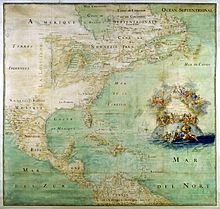新法兰西
新法兰西(法语:Nouvelle-France;英语:New France),法国位于北美洲的殖民地。北起哈德森湾,南至墨西哥湾,包含圣劳伦斯河及密西西比河流域,划分成加拿大、阿卡迪亚、纽芬兰岛、路易斯安那四个区域。[5]
新法兰西副王区 Viceroyauté de Nouvelle France | |||||||||||||||||
|---|---|---|---|---|---|---|---|---|---|---|---|---|---|---|---|---|---|
| 1534年—1763年 | |||||||||||||||||
 新法兰西在1721年在北美洲的疆域 | |||||||||||||||||
| 地位 | 法国殖民地 | ||||||||||||||||
| 首都 | 魁北克市 | ||||||||||||||||
| 常用语言 | 加拿大法语 | ||||||||||||||||
| 宗教 | 罗马天主教 | ||||||||||||||||
| 政府 | 君主制 | ||||||||||||||||
| 法兰西国王 | |||||||||||||||||
| 副王 | |||||||||||||||||
| 立法机构 | 新法兰西主权委员会 | ||||||||||||||||
| 历史 | |||||||||||||||||
• 建立 | 1534年 | ||||||||||||||||
| 1759年 | |||||||||||||||||
| 1760年 | |||||||||||||||||
| 1763年2月10日 | |||||||||||||||||
| 面积 | |||||||||||||||||
| 1750 | 8,000,000平方公里 | ||||||||||||||||
| 人口 | |||||||||||||||||
• 1750 | 90,000 | ||||||||||||||||
| 货币 | 新法兰西里弗尔 | ||||||||||||||||
| |||||||||||||||||

1524年,意大利航海家维拉萨诺探索了北美洲东岸并为新土地命名为佛朗西斯科,以纪念法国国王弗朗索瓦一世。但是,法国大部分人最初对这里未感兴趣。然而,法国渔船继续航行当地;而法国客商亦很快体会圣劳伦斯地区有大量可贵的毛皮,特别是海狸的毛皮在欧洲十分罕见。最终,法国人决定在此地拓殖,以扩展其在美洲的影响力。
为了保持毛皮贸易,法国人萨缪尔·德·尚普兰与当地的阿贡昆人和Montagnais人合作,对抗由其他原住民族组成的易洛魁联盟。他亦准备送年轻的法国人与当地人生活,学习他们的语言和风俗,以帮助法国人适应在北美洲的生活。这些人扩大了法国对南部和西部的影响。
当时南部的英国十三殖民地人口众多,而且十分富裕。路易十三的主要大臣黎塞留希望可以让新法兰西像英国殖民地一样富裕。他在新法兰西投资,任命尚普兰为新法兰西的总督。
之后,路易十四也禁止了非罗马天主教徒居住在新法兰西,使许多人改住在英国殖民地。
至18世纪中叶,法国定居点仍然发展较好。人口大约70000人,主要是靠自然增长。[6][7]在法国统治下的欧洲人人口增长缓慢。[8][9][10]南部沿着大西洋海岸的十三殖民地人口不断增长,并且有更多来自欧洲的移民。至1760年代,约有160万人居住在英国殖民地。人口与新法兰西相比是23比1。1763年七年战争结束后,英国接管了新法兰西北部地区,1867年这些地区被并入加拿大,法国于1803年将路易斯安那领地出售给美国,使美国的领土面积扩大了一倍。
目前,在前新法兰西的领土中,只剩下圣皮埃尔和密克隆仍然由法国控制。

参见
编辑参考资料
编辑- ^ New York State Historical Association. Proceedings of the New York State Historical Association with the Quarterly Journal: 2nd-21st Annual Meeting with a List of New Members. The Association. 1915 [2021-03-05]. (原始内容存档于2021-03-23).
It is most probable that the Bourbon Flag was used during the greater part of the occupancy of the French in the region extending southwest from the St. Lawrence to the Mississippi , known as New France... The French flag was probably blue at that time with three golden fleur - de - lis ....
- ^ Background: The First National Flags. The Canadian Encyclopedia. 28 November 2019 [1 March 2021]. (原始内容存档于2021-03-23).
At the time of New France (1534 to the 1760s), two flags could be viewed as having national status. The first was the banner of France — a blue square flag bearing three gold fleurs-de-lys. It was flown above fortifications in the early years of the colony. For instance, it was flown above the lodgings of Pierre Du Gua de Monts at Île Sainte-Croix in 1604. There is some evidence that the banner also flew above Samuel de Champlain’s habitation in 1608. ..... the completely white flag of the French Royal Navy was flown from ships, forts and sometimes at land-claiming ceremonies.
- ^ INQUINTE.CA | CANADA 150 Years of History ~ The story behind the flag. inquinte.ca. [2021-03-05]. (原始内容存档于2021-03-23).
When Canada was settled as part of France and dubbed "New France," two flags gained national status. One was the Royal Banner of France. This featured a blue background with three gold fleurs-de-lis. A white flag of the French Royal Navy was also flown from ships and forts and sometimes flown at land-claiming ceremonies.
- ^ Wallace, W. Stewart. Flag of New France. The Canadian Encyclopedia II. Toronto: University Associates of Canada: 350–351. 1948.
During the French régime in Canada, there does not appear to have been any French national flag in the modern sense of the term. The "Banner of France", which was composed of fleur-de-lys on a blue field, came nearest to being a national flag, since it was carried before the king when he marched to battle, and thus in some sense symbolized the kingdom of France. During the later period of French rule, it would seem that the emblem...was a flag showing the fleur-de-lys on a white ground.... as seen in Florida. There were, however, 68 flags authorized for various services by Louis XIV in 1661; and a number of these were doubtless used in New France
- ^ R. Douglas Francis; Richard Jones; Donald B. Smith. Journeys: A History of Canada. Cengage Learning. 2009: 51 [2016-06-02]. ISBN 0-17-644244-8. (原始内容存档于2021-03-23).
- ^ Estimated population of Canada, 1605 to present. Statistics Canada. 2009 [August 26, 2010]. (原始内容存档于2018-12-24).
- ^ David L. Preston. The Texture of Contact: European and Indian Settler Communities on the Frontiers of Iroquoia, 1667–1783. U of Nebraska Press. 2009: 43 [2017-10-21]. ISBN 978-0-8032-2549-7. (原始内容存档于2021-03-23).
- ^ John Powell. Encyclopedia of North American Immigration. Infobase Publishing. 2009: 203 [2017-10-21]. ISBN 978-1-4381-1012-7. (原始内容存档于2021-03-23).
- ^ Ronald J. Dale. The Fall of New France: How the French Lost a North American Empire 1754–1763. James Lorimer & Company. 2004: 2 [2017-10-21]. ISBN 978-1-55028-840-7. (原始内容存档于2021-03-23).
- ^ John E. Findling; Frank W. Thackeray. What Happened?: An Encyclopedia of Events that Changed America Forever. ABC-CLIO. 2011: 38 [2017-10-21]. ISBN 978-1-59884-621-8. (原始内容存档于2021-03-23).
![新法兰西上:法兰西王国旗帜 下:法兰西皇家旗帜[1][2][3][4]](http://upload.wikimedia.org/wikipedia/commons/thumb/8/82/Royal_flag_of_France.svg/125px-Royal_flag_of_France.svg.png)

